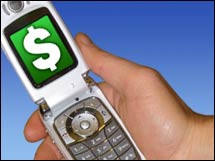Your cell phone = your walletAt long last, mobile phones have the ability to transfer cash wirelessly. So why aren't consumers using their handsets as their personal ATM this holiday season?(Business 2.0 Magazine) -- For nearly a decade, cell phone carriers have dreamed of the day when consumers can shop using their handhelds, not their wallets. One touch of the dial pad and the holiday scarf for Mom is sold. Only recently, however, has it become technologically viable for users to transfer money securely to and from their cell phones. In Japan and parts of Europe, consumers are actively buying stuff with their handsets. So U.S. carriers must be falling over themselves to sell phones with ATM-like capabilities here at home, right?
Think again. As it turns out, mobile phone operators are the ones holding up a new era of wireless money transfers in the United States. The reason: They haven't found a business model they like. Negotiations between carriers and consumer banks have recently stalled over when - and how much - users must pay when they buy double-shot lattes via their cell phones. The impasse is wilting once-rosy projections on the potential size of the mobile payments market. ABI Research recently cut by 10 percent the number of handsets it expects to ship in 2011 that have the 'near field communication' (NFC) technology that can beam payments from bank accounts to retailers. "This is not going to happen as quickly as we thought," says Jonathan Collins, an ABI senior analyst. "The business model needs to be hashed out before mobile payments can take off." A cash cow waiting to be drained The problem, explains Collins, is about rivalry and profit-sharing. With their tight grip on the mobile ecosystem, carriers have been reluctant to open up their customer base to banks, whom they also consider competitors. Fees are the other main sticking point. The phone carriers want a percentage of each sale made with a cell phone. But banks argue that's not a viable model because it will effectively mean higher prices for consumers. If mobile payment services aren't cheap and easy, the financial firms argue, consumers won't use them. Carriers have plenty of reasons to break the deadlock. The mobile payments market is expected to reach $55 billion by 2008, according to consulting firm Celent. A chunk of those riches will go to handset vendors like Motorola (Charts) and Nokia (Charts). But the carriers stand to reap untold ancillary revenues: If consumers can use their cell phone to buy movie tickets at the box office, the next logical step is mobile banking and other services that require customers to buy pricey data plans. Thomas Zalewski, a Nokia executive, agrees that the big promise of mobile payments for carriers lies in secondary services - and not in any direct fees from cell phone-based purchases. "Perhaps that's where they get a piece of the action." Niche carriers look for an advantage Analysts aren't making any predictions on when the standoff will end. For now, the most shoppers can hope for are rudimentary services from much smaller cell phone carriers. Known as "mobile virtual network operators" (MVNOs), these fledgling carriers lease spectrum from major carriers and chase after niche markets. Amp'd Mobile - an MVNO that targets music buffs, has rolled out a scaled-down service that lets consumers exchange money with each other via their cell phones. So, for instance, a father could text message $100 to his college son's cell phone. Helio, an MVNO aimed at young adults, will soon unveil the same service, called Obopay. The problem with the above scenario, however, is that both the father and the son must sign up for Obopay for the service to work. The only way they can purchase goods is with a traditional debit card, just like shoppers do today. So Obopay, while moving in the right direction, still has a ways to go. The service is working with both Helio and Amp'd Mobile to enable consumers next year buy with their phones. 7-Eleven is also pushing into mobile payments through its Speak Out Wireless cell phone service. Last month the convenience store chain began a trial service in its Dallas hometown that uses near field communication technology. 7-Eleven is testing the program with Nokia and MasterCard. But small players like 7-Eleven and Helio - a joint venture of Korea's SK Telecom and Earthlink - aren't about to snatch the mobile payment opportunity out from under the major carriers. Their collective customer bar is far too small, and likely to stay that way. "To really scale this you need a large carrier that's willing to take a chance," says Nokia's Zalewski. Like most handset makers, Nokia is eager to bring its NFC phones to the United States. But so far, no American carriers have ordered any - either from Nokia or any other device maker. They might be in for a long wait. "Mobile payments won't happen until the [major] carriers are confident they'll make money from this," says Collins, the ABI analyst. |
|

